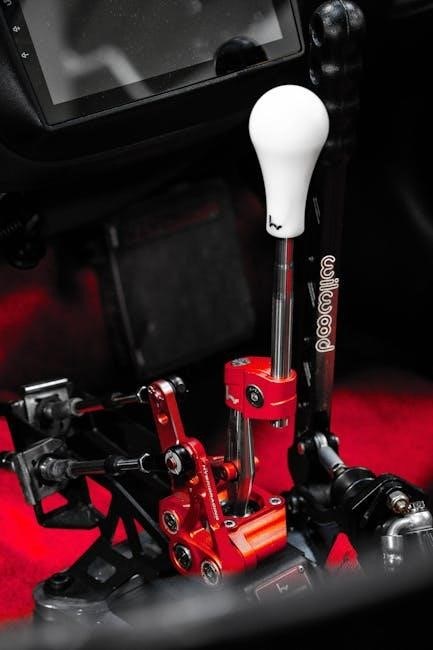Mustang Manual Gearbox: A Comprehensive Overview
Mustang’s manual transmissions evolved from the Borg-Warner T10 to modern Tremec gearboxes, offering enthusiasts engaging driving experiences. These transmissions have become standard-bearers.
Early models featured four-speeds, while the Fox Body era introduced the five-speed, and later, six-speed options like the Getrag MT82 and Tremec T-56.
Historical Context of Mustang Manual Transmissions
The introduction of the Ford Mustang in 1964 marked a turning point, initially relying on the robust Borg-Warner T10 manual transmission. This three-speed gearbox was a staple in the early years (1964-1966), providing a direct connection between driver and machine, a characteristic that would define the Mustang’s appeal.
As demand grew and performance expectations increased, Ford transitioned to more advanced options. The late 1960s and 70s saw the rise of four-speed manual transmissions, offering improved gear ratios and enhanced driving dynamics. However, the real shift occurred with the Fox Body Mustang in 1983, which embraced the five-speed manual transmission.
This five-speed, largely thanks to Tremec, became synonymous with the Mustang experience, providing a balance of performance and fuel efficiency. The evolution continued with the introduction of six-speed manuals, like the Getrag MT82 in the S550 generation, further refining the driving experience. Throughout its history, the manual transmission has remained a core element of the Mustang’s identity, appealing to enthusiasts who value control and engagement.
Early Mustang Transmissions: Borg-Warner T10 (1964-1966)
The Borg-Warner T10 was the original manual transmission found in the first generation Mustangs, from 1964 through 1966. Known as a “side-loader,” due to its unique case design allowing transmission removal without disturbing the torque tube, it quickly gained a reputation for durability and reliability. This three-speed manual was a key component in establishing the Mustang’s sporty image.
Initially, it was offered with various gear ratios to suit different engine options, providing a versatile solution for the burgeoning Mustang lineup. While not the most sophisticated transmission by today’s standards, the T10 offered a direct and engaging driving experience that resonated with early Mustang buyers.
Its robust construction made it capable of handling the power of the available engines, and its relatively simple design contributed to its longevity. As Ford and other manufacturers began developing their own in-house transmissions, the T10’s reign was limited, but its place in Mustang history as the first manual gearbox is firmly cemented.
The Four-Speed Era (1967-1982)
Following the Borg-Warner T10, the era from 1967 to 1982 saw a shift towards four-speed manual transmissions in Mustangs. Ford began utilizing its own designs, alongside continued offerings from Borg-Warner, providing a wider range of options for performance and driving preferences. These transmissions offered a more versatile driving experience, with closer gear ratios allowing for improved acceleration and overall control.
Various four-speed models were employed throughout this period, catering to different engine outputs and Mustang variants. The Toploader, a robust and highly regarded four-speed, became a popular choice, particularly in high-performance models. This era represented a significant step forward in Mustang transmission technology, offering increased refinement and capability.
While the three-speed T10 had served its purpose, the four-speed provided a more modern and engaging driving experience, aligning with the evolving performance expectations of Mustang enthusiasts. This period laid the groundwork for the later introduction of five and six-speed manual transmissions.
The 1983 model year marked a pivotal moment in Mustang transmission history with the introduction of a five-speed manual gearbox in the Fox Body Mustang. This arrival signified a substantial upgrade over the previous four-speed options, becoming the standard-bearer for gearboxes in late-model street cars. The five-speed offered a more refined and efficient driving experience, particularly for highway cruising thanks to its generous fifth-gear overdrive.
This change wasn’t merely about adding another gear; it represented a shift towards improved fuel economy and reduced engine wear during long journeys. The five-speed provided closer gear ratios, enhancing acceleration and overall performance. It quickly became a favorite among Mustang enthusiasts seeking a more engaging and connected driving experience.
The introduction of the five-speed in the Fox Body Mustang fundamentally altered the landscape of Mustang transmissions, setting the stage for further advancements in the years to come.
Getrag MT82 Six-Speed Transmission (S550 Mustangs)
The S550 Mustang generation (2015-2023) prominently featured the Getrag MT82 six-speed manual transmission as its standard offering for those preferring a stick shift. This gearbox represented a leap forward in technology, providing drivers with enhanced control and a more modern driving experience. However, the MT82 quickly became a subject of discussion within the Mustang community, largely due to reported reliability concerns.

While offering precise shifts and a satisfying mechanical feel, the MT82 was often criticized for its relatively short lifespan and susceptibility to issues like synchro wear and internal component failures. Many S550 owners began exploring alternatives, specifically the Tremec transmissions, as potential upgrades to address these concerns.
Despite its shortcomings, the MT82 played a crucial role in keeping the manual transmission alive in the Mustang lineup during a period when automatics were gaining dominance. It remains a significant part of the S550 Mustang story.
MT82 Common Issues and Reliability
The Getrag MT82, while a modern six-speed, unfortunately gained a reputation for reliability issues within the S550 Mustang community. A frequently reported problem centered around the transmission’s synchronizers, particularly those for 2nd and 3rd gear, exhibiting premature wear. This led to grinding during shifts, making the driving experience less enjoyable and potentially causing further damage.
Other common complaints included internal component failures, such as broken shift forks and worn bearings. Many owners reported needing to replace or rebuild the MT82 at relatively low mileage, often well before 100,000 miles. The transmission’s relatively weak design, coupled with the Mustang’s power output, contributed to these failures.
Consequently, a thriving aftermarket emerged offering upgraded components and complete Tremec transmission swaps. Owners actively sought solutions to overcome the MT82’s inherent weaknesses, highlighting a significant concern regarding its long-term dependability.
MT82 vs. Tremec: A Comparison
Comparing the Getrag MT82 to Tremec transmissions reveals significant differences in durability and driving feel. While the MT82 offered a modern six-speed configuration in the S550 Mustang, it consistently fell short of Tremec’s renowned robustness. Tremec’s T-5, TKO, and T-56 models are widely regarded as substantially stronger and more reliable.
The MT82’s internal components proved susceptible to wear, particularly under the stress of higher horsepower applications. Tremec transmissions, built with stronger materials and more robust designs, can handle significantly more power without experiencing premature failure. Shift quality also differs; Tremec units generally offer a more precise and satisfying engagement.
Consequently, many Mustang owners opted to retrofit Tremec transmissions into their vehicles, seeking a long-term solution to the MT82’s reliability concerns. This upgrade often involved replacing the entire drivetrain, but the improved durability and driving experience were considered worthwhile investments.
Tremec T-5 Five-Speed Transmission
The Tremec T-5 five-speed transmission quickly became a popular upgrade for classic Mustangs seeking improved highway cruising and overall drivability. Introduced as a robust alternative to older factory options, the T-5 offered a significant leap in both strength and efficiency. Its design allowed for relatively straightforward installation into various Mustang models, often requiring minimal modifications.
A key benefit of the T-5 is its overdrive fifth gear, which substantially reduces engine RPMs at highway speeds, leading to better fuel economy and reduced engine wear. This made it an ideal choice for owners who frequently embarked on long road trips. The T-5’s compact size also contributed to its ease of installation.
While not as powerful as the later TKO or T-56 models, the T-5 provided a substantial improvement over the original four-speed transmissions, offering a balance of affordability, reliability, and performance for a wide range of Mustang applications.
Tremec TKO Five-Speed Transmission

The Tremec TKO five-speed transmission represents a significant upgrade over the earlier T-5, designed for applications demanding greater strength and torque capacity. Often favored by Mustang owners with modified engines, the TKO boasts stronger internal components and a more robust case, making it suitable for handling higher horsepower levels. Installation generally requires minimal modifications, similar to the T-5, but may necessitate a different crossmember.
Like the T-5, the TKO features a convenient overdrive fifth gear, enhancing highway cruising comfort and fuel efficiency. However, the TKO’s gear ratios are often tailored for performance applications, providing quicker acceleration and improved overall responsiveness. This makes it a popular choice for both street and track use.
The TKO offers a noticeable improvement in shift feel compared to the T-5, providing a more precise and connected driving experience. It remains a highly sought-after upgrade for classic Mustangs seeking a blend of durability, performance, and drivability.
Tremec T-56 Six-Speed Transmission

The Tremec T-56 six-speed manual transmission is a premium upgrade for Mustangs, offering exceptional strength, precise shifting, and a wider gear ratio spread than the five-speed options. Originally designed for high-performance vehicles like the Chevrolet Corvette and Dodge Viper, the T-56 has become a favorite among Mustang enthusiasts seeking ultimate control and performance.
Its robust construction and ability to handle substantial horsepower and torque make it ideal for heavily modified engines. The six-speed configuration provides closer gear ratios, maximizing acceleration, while the overdrive sixth gear enhances highway cruising efficiency. Installation typically requires more extensive modifications than the T-5 or TKO, including a new transmission tunnel and potentially a custom driveshaft.
The T-56 delivers a distinctly sporty and engaging driving experience, with a short-throw shifter and precise gate action. It’s a significant investment, but for those prioritizing performance and durability, the Tremec T-56 is a top-tier choice.
Tremec Transmission Installation Considerations
Installing a Tremec transmission into a Mustang isn’t a simple bolt-in process; careful planning and preparation are crucial. Several factors demand attention, beginning with compatibility – ensuring the chosen Tremec model (T-5, TKO, or T-56) aligns with your Mustang’s year and engine. Modifications to the transmission tunnel are almost always necessary, particularly with the T-56, requiring welding and fabrication skills.
A new clutch, pressure plate, and flywheel are essential, matched to the engine’s power output. The driveshaft will likely need shortening or replacement to accommodate the Tremec’s length. Shifter location and linkage require adjustment or a complete aftermarket shifter assembly. Don’t overlook the speedometer cable or electronic speed sensor – adaptation is often needed for accurate readings.
Finally, consider the transmission crossmember; reinforcement or replacement may be required. Thorough research and potentially professional installation are recommended for a successful and reliable upgrade.

S650 Mustang Manual Transmission – Current Generation
The S650 Mustang, introduced in 2024, continues the tradition of offering a manual gearbox, though its reception has been mixed among enthusiasts. Ford equipped the S650 GT with a six-speed manual transmission, aiming to provide a connected driving experience. However, some drivers have expressed concerns regarding the gearbox’s feel and precision, leading to comparisons with the previous S550 generation and even consideration of older models like the GT350.
Despite these critiques, the S650’s manual option remains popular for those prioritizing driver engagement. The transmission features rev-matching technology, intended to smooth shifts, but opinions on its effectiveness vary. The Dark Horse model also offers a manual, potentially with refinements addressing earlier feedback.
Ultimately, the S650’s manual transmission represents Ford’s commitment to offering a choice for purists, even as automatic transmissions gain prevalence.
S650 Manual Transmission: Driver Feedback and Reviews

S650 Mustang manual transmission reviews are notably polarized within the enthusiast community. A significant portion of feedback, particularly from online forums like Reddit’s r/Mustang and Mustang6G.com, centers on the transmission’s perceived shortcomings compared to previous generations. Common complaints include a vague shift feel, a heavier clutch pedal, and a less precise engagement.
Many drivers suggest the transmission requires a deliberate effort to operate smoothly, contrasting with the more intuitive feel of the S550’s Getrag MT82 or the refined experience of the GT350’s gearbox. The rev-matching feature, while appreciated by some, is criticized by others for feeling artificial or intrusive.

However, some reviewers acknowledge the transmission’s robustness and potential for improvement with aftermarket modifications. Despite the criticisms, the manual S650 remains a desirable option for drivers prioritizing a traditional driving experience, even if it requires adaptation.
The Appeal of the Manual Gearbox in Modern Mustangs
Despite the increasing prevalence of automatic transmissions, the manual gearbox retains a strong appeal for many Mustang enthusiasts. This stems from a desire for a more connected and engaging driving experience, placing the driver firmly in control of the vehicle’s performance. The tactile feedback of shifting gears, the ability to precisely select the optimal ratio, and the overall sense of driver involvement contribute to this allure.
For purists, a manual transmission embodies the spirit of the original Mustang, harking back to a time when driving was a more active and rewarding pursuit. The availability of manual options, even in modern iterations like the S650, caters to this dedicated segment of the market.
Furthermore, the manual gearbox often unlocks a greater sense of driving satisfaction, particularly on winding roads or during spirited driving sessions, fostering a deeper connection between driver and machine.
Manual Transmission Maintenance
Mustang manual transmissions, while generally robust, require regular maintenance to ensure longevity and optimal performance. Key areas include fluid checks and changes; the manufacturer’s recommended fluid type is crucial for proper lubrication and synchronization. Inspecting shift linkage for wear or looseness is vital for precise gear engagement, preventing missed shifts and internal damage.
Regularly checking the clutch master and slave cylinders for leaks is essential, as hydraulic issues can lead to clutch engagement problems. Furthermore, monitoring for unusual noises during shifting – grinding, popping, or whining – can indicate internal wear or damage requiring immediate attention.
Preventative maintenance, such as adjusting the clutch pedal free play, can also extend the life of the system. Addressing minor issues promptly prevents them from escalating into costly repairs, preserving the driving enjoyment of your Mustang.
Common Manual Transmission Problems in Mustangs
Mustang manual transmissions, across various generations, exhibit common failure points. The Getrag MT82, found in S550 models, is notorious for its relatively short lifespan and susceptibility to third gear pop-out, often linked to weak synchros. Input shaft failure is another frequent issue with this gearbox.
Older Tremec T-5 transmissions can experience worn synchronizers, leading to grinding during shifts, particularly in first and second gear. Leaking seals are also common, resulting in fluid loss and potential damage. Clutch master and slave cylinder failures are prevalent across all manual transmission Mustangs, causing difficulty engaging or disengaging the clutch.
Worn shift linkage can contribute to imprecise shifting, while internal bearing failures can generate whining noises. Ignoring these symptoms can lead to catastrophic transmission failure, necessitating expensive repairs or replacements.
Clutch Replacement and Upgrades
Clutch replacement is a common maintenance item for Mustang manual transmission vehicles, typically performed between 60,000 and 100,000 miles, depending on driving habits. Symptoms of a failing clutch include slipping, difficulty shifting, and a spongy pedal feel. Upgrading the clutch presents opportunities to enhance performance.
For mild power increases, a heavy-duty stock-style clutch is sufficient. However, significant horsepower gains necessitate a performance clutch kit, featuring a stronger pressure plate, upgraded disc, and potentially a flywheel upgrade. Ceramic or metallic disc materials offer increased grip but can be harsher for daily driving.
Flywheel selection impacts weight and inertia, influencing engine responsiveness. Lightweight flywheels improve acceleration but can make the car more difficult to drive at low speeds. Proper break-in procedures are crucial for maximizing clutch life and preventing premature failure. Consider upgrading the clutch master and slave cylinders during replacement for improved reliability.
Overdrive Manual Transmission Options for Mustangs

Overdrive manual transmissions significantly enhance Mustang drivability, particularly for highway cruising, by lowering engine RPMs at speed. This improves fuel efficiency and reduces engine wear. Several options exist for Mustangs seeking this benefit, primarily centering around Tremec transmissions.
The Tremec T-5 and TKO five-speed manuals are popular choices for classic Mustangs, offering a relatively straightforward installation and a cost-effective overdrive solution. The Tremec T-56 six-speed provides even greater overdrive ratios and strength, suitable for high-horsepower applications.
Choosing the right overdrive depends on the Mustang’s engine output and intended use. Considerations include gear ratios, transmission strength, and installation complexity. Properly selecting the overdrive ratio ensures optimal performance and a comfortable driving experience. These upgrades transform older Mustangs into capable long-distance cruisers;
Choosing the Right Overdrive Transmission
Selecting the ideal overdrive manual transmission for your Mustang requires careful consideration of several factors. Engine horsepower and torque are paramount; higher output engines necessitate stronger transmissions like the Tremec T-56. For milder builds, the T-5 or TKO offer a balance of affordability and performance.
Intended use is crucial. Frequent highway driving benefits from a deeper overdrive ratio (e.g., 0.68:1), while primarily street-driven cars might prefer a slightly taller ratio; Installation complexity varies – the T-5 and TKO generally require fewer modifications than the T-56.
Budget also plays a role. The T-56 is the most expensive, while the T-5 is the most affordable. Researching specific gear ratios within each model is vital to ensure optimal performance and a comfortable cruising experience. Don’t overlook the cost of supporting components like a new clutch and driveshaft.
Benefits of an Overdrive Manual Transmission

Installing an overdrive manual transmission in your Mustang unlocks a wealth of advantages. Primarily, it significantly improves highway fuel economy by lowering engine RPMs at cruising speeds. This reduction in RPMs also translates to reduced engine wear and tear, extending its lifespan.

Overdrive enhances the driving experience with quieter, more relaxed highway cruising. The lower engine speeds minimize drone and vibration, making long journeys more comfortable. Performance benefits include improved acceleration in lower gears, as the transmission allows for better gear matching.
Furthermore, an overdrive transmission can allow you to retain the original rear-end gear ratio, avoiding the expense and complexity of a gear change. This is particularly useful for restorations or maintaining a specific driving feel. Ultimately, it’s a smart upgrade for any Mustang frequently driven on the open road.
Aftermarket Manual Transmission Options
The aftermarket offers a robust selection of manual transmissions for Mustangs, catering to various performance goals and budgets. Tremec remains a dominant force, with the T-5, TKO, and T-56 being popular choices for upgrades and retrofits.
Tremec’s transmissions provide enhanced durability and smoother shifting compared to many original factory units. Options range from relatively affordable five-speeds like the T-5, suitable for mild performance builds, to the more robust and expensive six-speed T-56, ideal for high-horsepower applications.
Beyond Tremec, other manufacturers offer solutions, though Tremec generally dominates the market. Careful consideration of horsepower ratings, intended use (street, strip, or track), and budget is crucial when selecting an aftermarket transmission. Installation often requires additional components like a new clutch, flywheel, and potentially a modified transmission crossmember.
Retrofitting a Tremec into an Older Mustang
Retrofitting a Tremec transmission into a classic Mustang is a popular upgrade, significantly enhancing the driving experience. However, it’s rarely a direct bolt-in process, requiring careful planning and often, several supporting modifications.
Commonly, this involves adapting the transmission mount, modifying or replacing the driveshaft to accommodate the new length, and ensuring compatibility with the existing or upgraded clutch and flywheel. The shifter location may also require adjustment or a new shifter assembly.
Depending on the original transmission, modifications to the transmission tunnel might be necessary to provide adequate clearance for the Tremec’s larger case. Kits are available from various suppliers that bundle many of the necessary components, simplifying the process. Thorough research and potentially professional installation are recommended to ensure a successful and reliable upgrade.
Resources for Mustang Manual Transmission Information
Numerous online and offline resources cater to Mustang manual transmission enthusiasts. Mustang6G.com, specifically the S550 Mustang Forum, provides a wealth of information, including discussions on Getrag MT82 and Tremec retrofits, and owner experiences.
Mustang Monthly Magazine frequently features articles on transmission upgrades and maintenance, offering valuable insights into various gearbox options. Reddit’s r/Mustang subreddit is a vibrant community where owners share experiences and advice regarding manual transmissions, including the newer S650 models.
Quora hosts discussions with knowledgeable individuals offering detailed answers about classic Mustang transmissions like the Borg-Warner T10. Additionally, Tremec’s official website provides specifications and technical information on their transmissions, and aftermarket suppliers often have detailed guides and support resources available.





